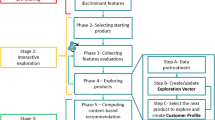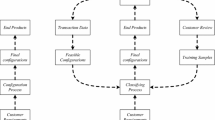Abstract
Mass customization systems aim to receive customer preferences in order to facilitate personalization of products and services. Current online configuration systems are unable to efficiently identify real customer affective needs because they offer an excess variety of products that usually confuse customers. On the other hand, mining affective customer needs may result in recommender systems, which can enhance existing configuration systems by recommending initial configurations according to customer affective needs. This paper introduces a mass customization recommender system that exploits data mining techniques on automotive industry customer data aiming at revealing associations between user affective needs and the design parameters of automotive products. One key novelty of the presented approach is that it deploys the Citarasa engineering, a methodology that focuses on the provision of the appropriate characterizations on customer data in order to associate them with customer affective needs. Based on the application of classification techniques we build a recommendation engine, which is evaluated in terms of user satisfaction, tool’s effectiveness, usefulness and reliability among other parameters.
Similar content being viewed by others
References
Adomavicius G., & Tuzhilin A. (2005) Toward the next generation of recommender systems: A survey of the state-of-the-art and possible extensions. IEEE Transactions on Knowledge and Data Engineering 17(6): 734–749
Agard B., Kusiak A. (2004) Data mining for subassembly selection. Journal of Manufacturing Science and Engineering 126(3): 627–631
Agard B., Kusiak A. (2004) Data-mining based methodology for the design of product families. International Journal of Production Research 42(15): 2955–2969
Agrawal, R., & Srikant, R. (1994). Fast algorithms for mining association rules. In: Proceedings of the 20th international conference of very large data bases (pp. 487–499). Santiago de Chile: Morgan.
Akao Y. (1972) New product development and quality assurance—Quality deployment system. (Japanese) Standardization and Quality Control 25(4): 7–14
Aldanondo M., Vareilles E. (2008) Configuration for mass customization: How to extend product configuration towards requirements and process configuration. Journal of Intelligent Manufacturing 19(5): 521–535
Armstrong, R., Freitag, D., Joachims, T., & Mitchell, T. (1995). Webwatcher: A learning apprentice for the world wide web. In Proceedings of the AAAI spring symposium on information gathering from heterogeneous, distributed environments (pp. 6–12). Stanford: AAAI Press.
Baralis E., Chiusano S., Garza P. (2008) A lazy approach to associative classification. IEEE Transactions on Knowledge and Data Engineering (TKDE) 20(2): 156–171
Bellifemine F., Caire G., Poggi A., Rimassa G. (2003) JADE: A white paper. EXP in search of innovation 3(3): 6–19
Bergenti, F. (2003). A discussion of two major benefits of using agents in software development. In Proceedings of engineering societies in the agents world III (pp. 11–81), Berlin Heidelberg, New York: Springer.
Burke, R. (2000). Knowledge-based recommender systems. In A. Kent (Eds.), Encyclopedia of library and information systems, 69(32).
Burke R. (2002) Hybrid recommender systems: Survey and experiments. User Modeling and User-Adapted Interaction 12(4): 331–370
Burke R. (2007) Hybrid Web Recommender Systems. In: Brusilovsky P., Kobsa A., Nejdl W. (eds) The adaptive Web: Methods and strategies of web personalization, lecture notes in computer science 4321. Springer, Berlin Heidelberg, New York, pp 377–408
Chang W. C., Wu T. Y. (2007) Exploring types and characteristics of product forms. International Journal of Design 1(1): 3–14
Chee, S., Han, J., & Wang, K. (2001). Rectree: An efficient collaborative filtering method. In Proceedings of the 3rd international conference on data ware-housing and knowledge discovery (DAWAK 2001), LNCS 2114 (pp.141–151). Munich, Germany: Springer.
Choudhary A. K., Harding J. A., Tiwari M. K. (2009) Data mining in manufacturing: A review based on the kind of knowledge. Journal of Intelligent Manufacturing 20(5): 501–521
Claypool, M., Gokhale, A., Miranda, T., Murnikov, P., Netes, D., & Sartin, M. (1999). Combining content-based and collaborative filters in an online newspaper. In Proceedings of the ACM SIGIR ’99 workshop on recommender systems: Algorithms and evaluation. Berkeley, California: ACM Press.
Coenen, F., Leng, P. & Zhang, L. (2005). Threshold tuning for improved classification association rule mining. In Proceedings of the Pacific-Asia conference on knowledge discovery and data mining (PAKDD ‘05), LNAI3158 (pp. 216–225). Hanoi, Vietnam: Springer.
Da Cunha C., Agard B., Kusiak A. (2006) Data mining for improvement of product quality. International Journal of Production Research 44(18/19): 4027–4041
Da Cunha C., Agard B., Kusiak A. (2010) Selection of modules for mass customization. International Journal of Production Research 48(5): 1439–1454
Felfernig, A., & Kiener, A. (2005). Knowledge-based interactive selling of financial services using FSA dvisor. In Proceedings of the 17th innovative applications of artificial intelligence conference (IAAI’05), (pp. 1475–1482). Pittsburgh, PA: AAAI Press.
Felfernig A., Friedrich G., Schmidt-Thieme L. (2007) Guest editors’ introduction: Recommender systems. IEEE Intelligent Systems 22(3): 18–21
Friesen G. B. (2001) Co-creation: When 1 and 1 make 11. Consulting to Management 12(1): 28–31
Huffman C., Kahn B. (1998) Variety for sale: Mass customization or mass confusion. Journal of Retailing 74: 491–513
Ishihara S., Ishihara K., Nagamashi M., Matsubara Y. (1995) An automatic builder for a Kansei engineering expert system using selforganizing neural networks. International Journal of Industrial Ergonomics 15(1): 13–24
Jiao R. J., Xu Q., Du J., Zhang Y., Helander M., Khalid H. M. et al (2007) Analytical affective design with ambient intelligence for mass customization and personalization. International Journal of Flexible Manufacturing Systems 19(4): 570–595
Jiang B., Wang W., Benbasat I. (2005) Multimedia-based interactive advising technology for Online consumer decision support. Communications of the ACM 48(9): 93–98
Khalaf R., Agard B., Penz B. (2010) An experimental study for the selection of modules and facilities in a mass customization context. Journal of Intelligent Manufacturing 21(6): 703–716(14)
Khalid, H., Dangelmaier, M., & Lim, T. Y. (2007). The CATER approach to vehicle mass customization. In Proceedings of the IEEE international conference on industrial engineering and engineering management (pp. 1273–1276). Singapore: IEEE.
Khalid H. M., Opperud A., Radha J. K., Xu Q., Helander M. G. (2011) Elicitation and analysis of affective needs in vehicle design. Theoretical Issues in Ergonomics Science 9(1): 1–7
Konstan J., Miller B., Maltz D., Herlocker J., Gordon L., Riedl J. (1997) Grouplens: Applying collaborative filtering to usenet news. Communications of the ACM 40(3): 77–87
Krulwich, B., & Burkey, C. (1996). Learning user information interests through extraction of semantically significant phrases. In Proceedings of the AAAI spring symposium on machine learning in information access. Stanford, CA: AAAI Press.
Kusiak A, Smith M. R., Song Z. (2007) Planning product configurations based on sales data. IEEE Transactions on Systems, Man, and Cybernetics: Part C 37(4): 602–609
Kusiak A., Smith A. (2007) Data mining in design of products and production systems. IFAC Annual Reviews in Control 31(1): 147–156
Lang, K. (1995). Newsweeder: Learning to filter netnews. In Proceedings of the 12th international conference on machine learning, (pp. 331–339). Tahoe City, California.
Lieberman, H. (1995). Letizia: An agent that assists web browsing. In Proceedings of the 14th international joint conference in artificial intelligence (IJCAI’95) (pp. 924–929). Montreal, Quebec, Canada.
Linden G., Smith B., York J. (2003) Amazon.com recommendations: Item-to-Item collaborative filtering. IEEE Internet Computing 7(1): 76–80
Li, W., Han, J., & Pei, J. (2001). CMAR: Accurate and efficient classification based on multiple-class association rule. In Proceedings of the international conference on data mining (ICDM’01) (pp. 369–376). San Jose, California: IEEE Computer Society Press.
Liu, B., Hsu, W., & Ma, Y. (1998). Integrating classification and association rule mining. In Proceedings of the 4th international conference knowledge discovery and data mining (pp. 80–96). New York, USA: AAAI Press.
Maslow A. H. (1943) A theory of human motivation. Psychological Review 50: 37–396
Matsubara Y., Nagamachi M. (1997) Hybrid Kansei engineering system and design support. International Journal of Industrial Ergonomics 19(2): 81–92
Melville, P., Mooney, R., & Nagarajan, R. (2001). Content-boosted collaborative filtering. In Proceedings of the SIGIR2001 workshop on recommender systems. New Orleans, LA: ACM Press.
Mobasher B. (2007) Data mining for web personalization. In: Brusilovsky P., Kobsa A., Nejdl W. (eds) The adaptive web: Methods and strategies of web personalization, lecture notes in computer science, 4321. Springer, Berlin Heidelberg, New York, pp 90–135
Moon S. K., Simpson T. W., Kumara S. R. T. (2009) An agent-based recommender system for developing customized families of products. Journal of Intelligent Manufacturing 20(6): 649–659
Nagamachi M (2002) Kansei engineering as a powerful consumer-oriented technology for product development. Applied Ergonomics 33: 289–294
Papazoglou M. (2001) Agent-oriented technology in support of E-business. Communications of the ACM 44(4): 71–77
Pazzani M. (1999) A framework for collaborative, content-based and demographic filtering. Artificial Intelligence Review 13(5–6): 393–408
Pine II, B. J. (1992). Mass customization: The new Frontier in business competition. Boston, Mass: Harvard Business School. (ISBN 0-87584-946-6).
Piller F., Schubert P., Koch M., Möslein K. (2005) Overcoming mass confusion: Collaborative customer co-design in online communities. Journal of Computer-Mediated Communication 10(4): 1–25
Quinlan, J. R., & Cameron-Jones, R. M. (1993). FOIL: A midterm report. In Proceedings of ECML-93 (pp. 3–20). Vienna, Austria: Springer.
Schafer B., Frankowski D., Herlocker J., Sen S. (2007) Collaborative Filtering Recommender Systems. In: Brusilovsky P., Kobsa A., Nejdl W. (eds) The adaptive web: Methods and strategies of web personalization, lecture notes in computer science, 4321. Springer, Berlin Heidelberg, New York, pp 291–324
Schwab, I., Kobsa, A. & Koychev, I. (2000). Learning about users from observation. In Adaptive user interfaces: Papers from the 2000 AAAI spring symposium. Menlo Park, CA: AAAI Press.
Shardanand, U., & Maes, P. (1995). Social information filtering: Algorithms for automating “word of mouth”. In Proceedings of CHI’95-Human factors in computing systems (pp. 210–217). Colorado, USA: ACM press.
Song Z., Kusiak A. (2009) Optimizing product configurations with a data-mining approach. International Journal of Production Research 47(7): 1733–1751
Stormer H. (2009) Improving product configurators by means of a collaborative recommender system. International Journal of Mass Customisation 3(2): 165–178
Sugita, K., Ishida, T., Miyakawa, A., & Shibata, Y. (2004). Kansei retrieval method based on design pattern of traditional Japanese crafting object. In Proceedigs of the 15th international workshop on database and expert system applications DEXA 04 (pp. 308–312). Zaragoza, Spain: Springer.
Sun, Y., Wong, A. & Wang, Y. (2006). An overview of associative classifier. In Proceedings of the 2006 international conference on data mining (pp. 138–143). Las Vegas: Nevada.
Thabtah F. (2007) A review of associative classification mining. The Knowledge Engineering Review 22(1): 37–65
Thompson C., Göker M., Langley P. (2004) A personalized system for conversational recommendations. Journal of Artificial Intelligence Research 21: 393–428
Tseng M. M., Jiao J. (2001) Mass customization. In: Salvendy G. (eds) Handbook of industrial engineering 3rd edition. Wiley, New York, pp 684–709
Witten Ian H., Frank E. (2005) Data mining: Practical machine learning tools and techniques with java implementations. Morgan Kaufmann, San Francisco
Wooldridge M. (2009) An introduction to multiAgent systems. Wiley, NY
Yin, X. & Han, J. (2003). CPAR: Classification based on predictive association rules. In Proceedings of the third SIAM international conference on data mining (pp. 369–376). San Francisco, CA USA: SIAM Press.
Zhang Y., Jiao J. (2007) An associative classification-based recommendation system for personalization in B2C E-commerce applications. Expert Systems with Applications 33(2): 357–367
Zhu B., Wang Z., Yang H., Mo R., Zhao Y. (2008) Applying fuzzy multiple attributes decision making for product configuration. Journal of Intelligent Manufacturing 19(5): 591–598
Author information
Authors and Affiliations
Corresponding author
Rights and permissions
About this article
Cite this article
Mavridou, E., Kehagias, D.D., Tzovaras, D. et al. Mining affective needs of automotive industry customers for building a mass-customization recommender system. J Intell Manuf 24, 251–265 (2013). https://doi.org/10.1007/s10845-011-0579-4
Received:
Accepted:
Published:
Issue Date:
DOI: https://doi.org/10.1007/s10845-011-0579-4




